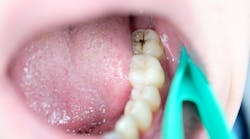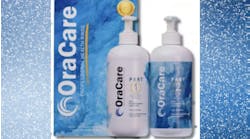Donna Lynn Brogan, RDH
Traditionally, dental professionals have provided fluoride varnish treatments to children in the caries-active stage. However, the face of caries has changed. Large cohort studies have shown that adults are a caries-active group, experiencing disease at a rate that is comparable to that of adolescents.1
Risk factors such as recession, use of prescription medication, poor biofilm removal, multisurface restorations, and recent carious activity all put adults at risk for developing caries. These risk factors, for example, are prevalent among people in their 40s and 50s.
While the most recognized use of fluoride varnish in adults is for dentin desensitization, the practice of caries management by risk assessment (CAMBRA) has opened clinicians’ minds to a more widespread and purposeful use. This article will look at how fluoride varnish can be used more purposefully.
Clinical recommendations
In 2013, the Council on Scientific Affairs of the American Dental Association published evidence-based clinical recommendations for the use of professionally applied topical fluorides for all ages.2 Two types of professionally applied fluoride were recommended: 5% fluoride varnish and four-minute, tray-applied acidulated phosphate (APF) gel. Because a large number of adults have composite, porcelain, or ceramic restorations that disqualify the use of APF, this article will focus on fluoride varnish.
Caries development in adults
There are many conditions that predispose adults to caries development—and therefore preventive treatment. Let’s review some of these conditions here.
In adults, small interproximal restorations frequently deteriorate over time and progress to become large lesions, eventually resulting in the need for a crown. If xerostomia or recession is present, clinicians will often observe an ominous dark line at the crown margin. This restorative progression is irreversible and leads to more aggressive treatment and tissue loss. Adults must be followed closely to prevent this.
One of the most significant factors in caries development is exposed root surfaces. While enamel demineralizes at a pH of 5.5, exposed root surfaces demineralize at a pH much closer to neutral, 6.2–6.7.3 Dentin and cementum demineralization occurs twice as fast compared to enamel because of their significantly lower mineral content. As a result, initiation and progression of root caries is more rapid. For adult patients, root caries is an ugly outcome, often having negative effects that are far-reaching.
Adults with xerostomia are a group at risk for rapid progression of caries.4 More than 400 medications contribute to xerostomia,5 which is notable considering that 68% of Americans take prescription medication.6 In fact, over half of Americans are on two medications, and 21% are on five or more.6 Saliva clears away debris and has the capability to buffer acid attacks. Without saliva, enamel isn’t exposed to calcium and phosphate, and remineralization cannot occur.7 Instead of the beautiful demineralization-remineralization balance, teeth are plunged into a downward spiral of demineralization.
High-risk patients
Patients who have been diagnosed with decay during the last 24 months are considered high risk for caries development.2 They are very likely to develop recurrent decay in the same location or at a new site because the bacterial infection is ongoing. Simply removing decay and placing a restoration is not enough; the oral cavity must achieve a bacterial balance in order to reduce the cariogenic attack.8
For these patients, after a restoration of any kind has been placed due to caries activity, a fluoride varnish treatment should be performed at subsequent recall visits until the patient has had two caries-free years.2 In addition to professionally applied fluoride, the use of remineralization products, home fluoride, xylitol gum, and pH stabilization may be indicated. Many companies provide these therapeutic products, including CariFree, Xlear, and GC America.
Some companies provide educational tools that dental professionals can use to discuss dental health issues with patients. For example, Centrix offers downloadable support tools for adult varnish application, such as waiting room videos and caries-risk assessment forms. Other companies offering educational and marketing tools include Philips Sonicare and Sunstar Gum.
Assessing risk and educating patients
Here is a partial list of proven risk factors for adults.2
- Active caries in previous 24 months (automatically designates patient as high-risk)
- Cariogenic diet
- Chemotherapy or H/N radiation therapy
- Many multisurface restorations
- Poor oral hygiene
- Presence of exposed root surfaces
- Restoration overhangs and exposed margins
- Xerostomia induced by medication, radiation, or disease
Numerous risk assessments with simple checklists enable clinicians to determine caries risk and show patients their level of risk for caries development. These assessments conveniently divide patients into low-, moderate-, or high-risk groups and can be a wonderful educational tool to involve patients in their preventive treatment plan. Forms are available from dental associations that help dental professionals quickly and easily explain to their patients their risk levels and encourage patient acceptance for recommended treatment.
Varnish application in adults
Depending on the elevated risk category, applying varnish two to four times a year is recommended.9 However, many clinicians do not routinely apply varnish for adult patients. Reasons include the following:
- lack of insurance coverage
- difficulty placing varnish
- poor taste and appearance
- the unacceptable sensation the patient feels for hours after treatment
One reason for not applying varnish multiple times a year when required is that a patient may visit the office twice a year (every six months). Suffice to say, this roadblock and others have limited the use of an important tool that can be very successful in disease prevention.
Manufacturers have heard these criticisms and have adjusted their fluoride varnish products. If your fluoride varnish is clumping on the applicator brush, tastes bad, or is visible on the teeth, try another product. If adults complain about the fuzzy feeling in their teeth or the sticky residue on soft tissue, try another product. A suggested varnish is one that is smooth, clear, never stringy or clumpy, and in a flavor that adults prefer. FluoroDose from Centrix Dental and many other products now meet this description.
Technique
Fluoride varnish is easy to apply. It doesn’t require a chair or even an operatory. It does not have to be applied in the supine position, and the clinician doesn’t need an overhead light or saliva ejector.
If risk assessment determines that a patient would benefit from treatment four times a year but the patient has only two recalls, there’s an alternative to the dental chair: the patient can sit in a normal chair in the consultation room or any private area. Application of the varnish takes less than one minute, allowing patients only a brief interruption to their day.
Fluoride varnish application is easiest when done “face-to-face.” The clinician should face the patient so they are close to the same height. Have the patient swallow, open, and look slightly down. Using a unit-dose delivery system, the clinician loads the applicator brush and swipes varnish along the lingual of the mandibular arch. Have the patient look straight ahead with teeth together, retract the left cheek with a mouth mirror, load the applicator brush as needed, and swipe the facial of both arches. Retract the right cheek and repeat. Instruct the patient to open and look up, reload the applicator, and swipe the lingual of the maxillary arch. Supply the patient with a disposable cup and tissue so they can expectorate as desired. Use of a saliva ejector is contraindicated, as all varnish products have the opportunity to harden inside hoses and clog lines.
This application technique can be used after the recall examination in the operatory, but it is just as easily performed in a consultation room. It takes just a minute and does not require the effort or cost of turning over a room. Fluoride varnish patients can be scheduled between hourly blocks, and any qualified dental professional available can easily perform a varnish treatment for drop-in patients.
Cost
Addressing the insurance question upfront is imperative. Given the possible negative outcomes of caries, varnish application for a small fee is preferable to more extensive treatment later on. Fluoride varnish is inexpensive (as low as $1, depending on the product), and this application technique will keep costs minimal for subsequent patient visits.
There is a wide variation in fees across practices, ranging from $15 to $95, but a fee of about $25 is acceptable to most patients for the one-minute application—especially given the cost of more complicated treatments down the road. Keeping the fee low will result in more patients accepting treatment. As a result, the practice will treat more complicated oral health needs and provide an additional revenue stream for the practice, which is a win-win for everyone.
References
1. Thomson WM. Dental caries experience in older people over time: what can the large cohort studies tell us? Br Dent J. 2004;196(2):89-92.
2. ADA Scientific Panel issues evidence-based clinical recommendations: Patients at elevated risk for developing cavities benefit from applying topical fluoride. American Dental Association website. https://www.ada.org/en/press-room/news-releases/2013-archive/november/ada-scientific-panel-issues-evidence-based-clinical-recommendations. Published November 01, 2013.
3. Wilkins EM. Clinical Practice of the Dental Hygienist. 9th ed. Philadelphia, PA: Lippincott Williams & Wilkins. 2005:(393-401).
4. Doméjean-Orliaguet S, Gansky SA, Featherstone JD. Caries risk assessment in an educational environment. J Dent Educ. 2006;70(12):1346-1354.
5. Litt JZ, Shear N. Litt’s Drug Eruption and Reaction Manual. 22nd ed. 2016:408.
6. Zhong W, Maradit-Kremers H, St. Sauver JL, et al. Age and sex patterns of drug prescribing in a defined American population. Mayo Clin Proc. 2013:88(7):697-707.
7. Gonzalez-Cabezas C. The chemistry of caries: remineralization and demineralization events with direct clinical relevance. Dent Clin N Am. 2010;54(3):469-478.
8. Marsh PD. Microbiology of dental plaque biofilms and their role in oral health and caries. Dent Clin N Am. 2010;54(3):441-454.
9. Azarpazhooh A, Main PA. Fluoride varnish in the prevention of dental caries in children and adolescents: a systematic review. J Can Dent Assoc. 2008;74(1):73-79.
Donna Lynn Brogan, RDH, is a graduate and past faculty member of the University of Oklahoma dental hygiene program. An educational consultant for more than 20 years, Donna has presented a wide range of topics online and throughout the world.






